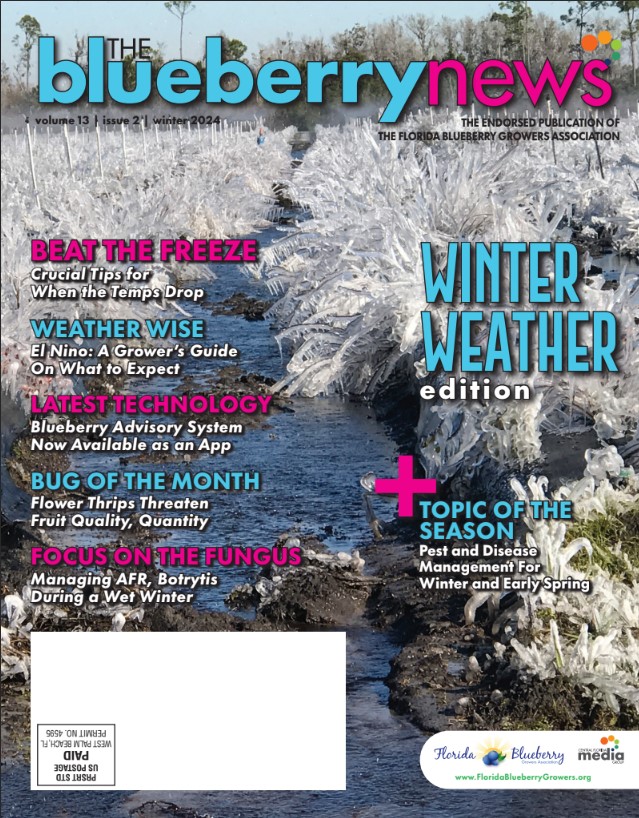January – March
|
Disease |
Once bloom occurs, monitor for Botrytis flower blight during cool wet periods. If present, spray suggested fungicides in rotation. Applications of fungicides prior to a forecasted need for overhead irrigation as freeze protection can help reduce Botrytis severity on plants damaged by low temperature injury. See UF EDIS Publication PP198, Botrytis Blossom Blight of Southern Highbush Blueberry (https://edis.ifas.ufl.edu/publication/PP119). Anthracnose (ripe rot) infections can begin as early as bloom; consider making preventative fungicide applications and using the Blueberry Advisory System (BAS) for notifications of increased disease development risk (http://cloud.agroclimate.org/tools/bas/dashboard/disease); the BAS is also now available as a phone app. January - Apply Ridomil to help prevent Phytophthora root rot. See HS1156, 2022 Florida Blueberry Integrated Pest Management Guide (https://edis.ifas.ufl.edu/publication/HS380). |
|
Insect Pests |
Continue to monitor for blueberry gall midge and spray suggested insecticides when adults are observed. If traps are not used, spray before floral and vegetative bud break, with a second spray approximately 7-10 days after the first application, following label directions. See UF EDIS Publication ENY-997, Blueberry Gall Midge on Southern Highbush Blueberry in Florida (https://edis.ifas.ufl.edu/publication/IN1239). Also scout for scales, southern red mites and flat mites, flower thrips, and blueberry bud mites, and if observed use applicable control measures. See UF EDIS Publications ENY-1006, Mite Pests of Southern Highbush Blueberry in Florida (https://edis.ifas.ufl.edu/in1284) and HS1156, 2022 Florida Blueberry Integrated Pest Management Guide (https://edis.ifas.ufl.edu/publication/HS380) for detailed suggestions. |
|
Weeds |
January – February – Apply post-emergence herbicide if weeds are at densities that hinder bush growth. March - Apply a pre-emergence herbicide for warm season weeds (tank mix with a post-emergence herbicide if weeds are at a density that hinders bush growth). |
|
Freeze Protection |
Monitor forecasted and actual temperatures and utilize freeze protection strategies as needed. See UF EDIS publication HS968, Protecting Blueberries from Freezes in Florida (https://edis.ifas.ufl.edu/publication/HS216). |
|
Pruning |
Dormant pruning can be performed to maintain appropriate plant structure and size. Removal of approximately 25% of old canes should be done annually beginning when a plant is five to six years old, to promote the growth of new canes. Low branches, weak growth, and damaged wood can also be removed at this time. See UF EDIS publication HS1359, Pruning Southern Highbush Blueberry in Florida (https://edis.ifas.ufl.edu/publication/HS1359). |
|
Managed Bees |
Have honey bees (and bumble bees if applicable) delivered; should ideally be placed in the field after 10% bloom but before 20% bloom. On large farms, hives should be distributed throughout the farm to the extent it still allows access to bee providers. Confirm health of colonies upon delivery; at least 8 frames per hive should have adults, and at least 6 frames should have brood in the cells, with good activity into and out of the hives and on the bushes. Consider adding additional honey bee or bumble bee hives if there is a heavy, concentrated bloom across the farm, nearby competing crops or wild plants blooming at the same time, or ongoing poor weather conditions (cold, windy, or overcast). Bee hives should be kept in the field through the end of bloom for all cultivars. See additional details in EDIS Publication ENY-172, Pollination Best Practices in Southern Highbush Blueberry in Florida (https://edis.ifas.ufl.edu/publication/IN1237). |
CREDIT:
DOUG PHILLIPS, Blueberry Extension Coordinator





